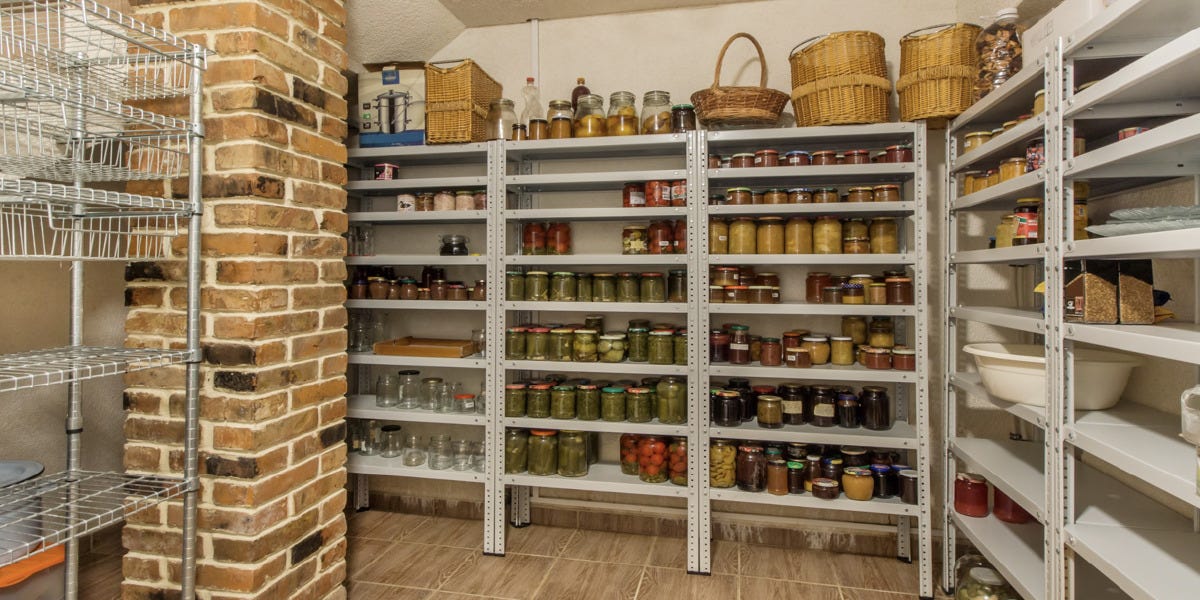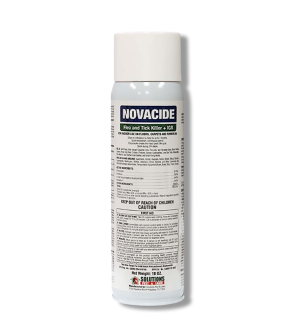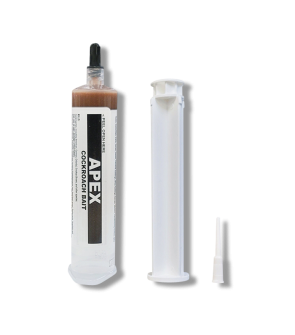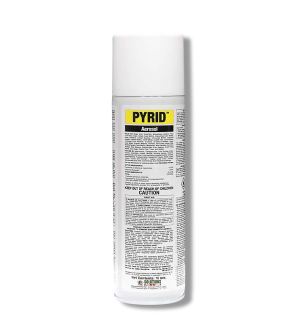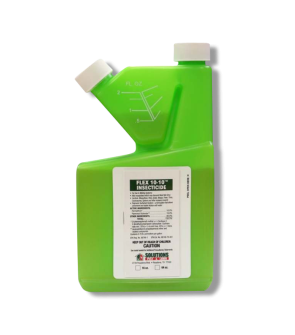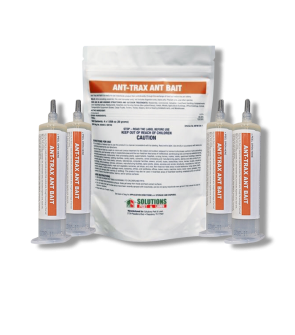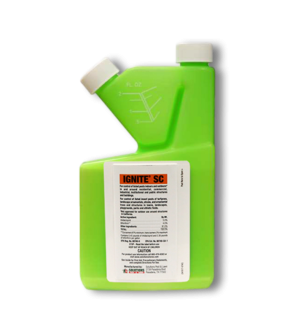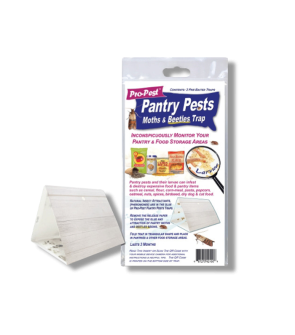Insects in Pantry/Food Storage
Most Effective Products
Common Insects in Pantry and Food Storage
More things raid your pantry and food storage area than common pantry pests. In addition to pests such as Indian meal moths, cigarette beetles, saw-toothed beetles, rice weevils, and flour beetles there are pharaoh ants and German cockroaches.
These pests are nibbling your food, multiplying, spreading harmful bacteria, and slowly taking over more than just your pantry and food storage areas. These pests can be hidden from view for some time in your home and spoil your food before you have the chance to enjoy it.
Cigarette Beetles
Cigarette beetles are known for their attacks on tobacco, but they will also infest pantry foods and pet food making them a nuisance for homeowners. These pests will breed inside packaged goods and contaminate them with eggs, dropped body parts, and feces.
Identification
The cigarette beetle is an oval-shaped beetle that measures approximately 1/8th of an inch. They are reddish brown in color, have six legs, serrated antennae, and possess a pair of smooth wings capable of flight.
Larvae of cigarette beetles are white, c-shaped grubs with long hairs covering the body. They also have a brown head capsule, three set of legs, and measure 2-3 mm in length.
Inspection

Treatment
Step 1: Thoroughly Clean
Clean cabinets, shelves, drawers, and floors out by tossing away all food stuff in those sites where first pest activity occurred. It's important to store all new food stuff in a sealable plastic container.
When these sites are empty begin by vacuuming to clear off any food residue, especially in the corners.
We also recommend taking a towel soaked with warm water to remove any food odors and residue not seen.
Step 2: Spray Pyrid Aerosol

Once these areas are clean and food is properly removed, treat cracks and crevices with Pyrid Insecticide Aerosol.
Be sure to also remove dishes, utensils, and food processing equipment before applying this product.
Pyrid Insecticide Aerosol is a ready to use aerosol insecticide that kills a variety of crawling and flying pests such as cigarette beetles.
Shake the can well before application and attach the red applicator straw for crack and crevice treatment. Insert the straw into cracks, crevices, and corners of pantries, cabinets, food processing equipment and handling equipment and other places where these pests harbor.
Spray along the length of these openings at a rate of 1 second per foot.
Step 3: Apply Flex 10-10
 When Pyrid Aerosol Insecticide has dried, use another insecticide like Flex 10-10 to create a residual barrier for further cigarette beetle control.
When Pyrid Aerosol Insecticide has dried, use another insecticide like Flex 10-10 to create a residual barrier for further cigarette beetle control.
Flex 10-10 is a permethrin and pbo based concentrate insecticide that eliminates and prevents cigarette beetles after application. To treat general surfaces, you will need a handheld pump sprayer.
For standard cigarette beetle control as a surface application, mix 3.2 fl. oz. of Flex 10-10 per gallon of water per 750 sq. ft. For heavy cigarette beetle infestations as a surface application, use 6.4 fl. oz. of product per gallon of water per 750 sq. ft.
Only when used as a surface application, spray floors, walls, and other surfaces like under pallets, behind shelves and drawers, around the base of machinery, and other hiding places.
Avoid spraying into machinery openings or electrical equipment.
Step 4: Trap Cigarette Beetles

Pro-Pest Pantry Moth & Beetle Traps are glue boards infused with pheromones that pantry moths and other stored products pests like cigarette beetles cannot resist. They can be hung or placed flat to control and detect these pests.
To use, peel back the wax paper off the adhesive then place them flat on surfaces or fold them into a triangle shape.
Each Pro-Pest Pantry Moth & Beetle Traps will cover 300 sq. ft. Place each pheromone glue trap in an area it will not be crushed which could be near the corners or light sources of pantries and food storage sites.
Once set, the Pro-Pest Pantry Moth & Beetle Traps will last for 3 months to determine where cigarette beetles are active and monitor for future activities.
Pheromone traps can suppress adult cigarette beetles, but do not eliminate larvae infestations so regular cleaning and pesticide applications are still recommended.
Flour Beetles
There are two flour beetles commonly found in pantries and food storage: the confused flour beetle and the red flour beetle. Both are similar in their habitats and appearance and both are often found together.
Damage from the adults and larvae are not generally seen in food items until the population becomes quite extensive. The longer they are present in foodstuff the increase of odor rises as well as becoming a nuisance in other parts of your home.
Identification
For a visual representation look at the image above: On the left is the red flour beetle and on the right is the confused flour beetle.
Red flour beetles have a rust red color, and about 1/8th of an inch long. They can be differentiated from confused flour beetles by the last 3 segments of their antennae.
Red flour beetles can also be differentiated from confused flour beetles by their ability to fly short distances. Confused flour beetles never fly.
On confused flour beetles, the last 4 segments of their antenna form a club. Much like red flour beetles these small beetles are also reddish brown in color and 1/8th of an inch long in length.
Larvae of both species are yellowish white to light brown in color and slender, cylindrical shape in appearance. They have 3 pairs of legs towards the front of their body and measure 1/7th of an inch long.
Inspection
Unlike the red flour beetle who can fly readily, confused flour beetles rely on people for transportation.
Once inside pantries and food storage sites, these pests can be found in a variety of grain and food materials like cereals, macaroni, flour, birdseed, beans, broken grains, spices, cacao, dried fruit, chocolate, and dried vegetables.
Both of these beetles cannot infest whole grains, but can feed on broken corn kernels and grain dust.
Red flour beetles have a rust red color, and about 1/8th of an inch long. They can be differentiated from confused flour beetles by the last 3 segments of their antennae.
Red flour beetles can also be differentiated from confused flour beetles by their ability to fly short distances. Confused flour beetles never fly.
On confused flour beetles, the last 4 segments of their antenna form a club. Much like red flour beetles these small beetles are also reddish brown in color and 1/8th of an inch long in length.
Larvae of both species are yellowish white to light brown in color and slender, cylindrical shape in appearance. They have 3 pairs of legs towards the front of their body and measure 1/7th of an inch long.
Treatment
Step 1: Deep Clean
One of the most effective things you can do is to take the time to deep clean your pantries and food storage areas from time to time.
Begin by throwing away all stored products where infestation occurred. Next, take a vacuum to remove food crumbs from corners, sides, top, and bottom of pantries, shelves, cabinets, and other areas where food was stored.
Wipe these areas down with a towel soaked with warm water to further remove food residue.
After you have thoroughly cleaned these sites, dispose of all trash outside in a trash can that is several feet away from your home's foundation.
Each new food item that is brought into pantries and food storage sites should be kept in an airtight sealable container to deter flour beetles.
Step 2: Treat Cracks and Crevices

Spray Pyrid Insecticide Aerosol to flush out these pests and to kill them upon contact.
To treat cracks and crevices with Pyrid Insecticide Aerosol, take off the white actuator and attach the red applicator straw.
Shake the can well then spray along the length of the crack and crevice at rate of 1 second per foot.
Step 3: Spray Residual Insecticide

Flex 10-10 will need to be applied as a general surface spray with a handheld pump sprayer.
Use 3.2 fl. oz. of Flex 10-10 with 1 gallon of water to treat 750 sq. ft. of surface area for light flour beetle infestations. For heavier infestations, apply 6.4 fl. oz. of product per gallon of water.
To mix, fill the sprayer with half the amount of water then add in the measured amount of Flex 10-10. Pour in the remaining half of water then shake until the solution is well-mixed.
Spray the mixed Flex 10-10 on a low-pressure setting to the back and side of the empty pantry shelving where the shelf meets the wall. Direct the spray into any cracks and crevices in shelving as well.
You may also treat under pallets, the surface on sites around the containers of stored food, around the base of machinery and behind shelves and drawers. Avoid spraying into machinery openings or electrical equipment.
German Cockroach
Like most other pantry pests, German cockroaches are attracted to pantries and food storage sites by the promise of food and shelter. These roaches have been known to carry all sorts of harmful pathogens and the more it lingers in food sites puts you and your family at risk.
Identification
German cockroaches are light brown to tan in color with two dark, parallel stripes on their heads. Though these cockroaches do not fly they prefer to run very quickly with their six legs.
German cockroaches are very small at about ½ of an inch in length.
Inspection
German cockroaches love warm, moist environments or tiny, dark spaces. Since they thrive on food they can hide in cracks and crevices under cupboards, cabinets, and shelves where food is stored or prepared.
Moisture sites near pantries and food storage spaces like under sinks and cracks or voids around window and door frames are favored by these pests.
They can also hide in nearby appliances like toasters, coffee makers, blenders, and sometimes refrigerators. Underneath or behind appliances such as microwaves, juicer, stove, or refrigerator are favored by German roaches during the day.
Treatment
Step 1: Thorough Sanitation
Exposed food crumbs in food storage sites or partially rolled up chip bags sitting on shelves in pantries are one of several reasons German cockroaches are invading these sites. Not to mention the overall aroma of food.
Cleaning the pantries of clutter and eliminating food sources by wiping off shelves with a warm, wet rag can help deter these pests. It is also necessary to store all eaten or uneaten food sources in a sealable plastic container.
Sweep and vacuum off floors regularly at least once a week to remove food crumbs for this pest to feed upon.
Make sure to switch all older food products to the front so they can properly be disposed of since the longer it sits out the more it emits attracting food odors for German cockroaches.
Make it a habit to wipe down counters, shelves, and floors and take trash out each week.
Step 2: Apply Apex Cockroach Gel Bait
Another used and commonly effective form of roach control is gel baits. Be aware that most baits cannot be used near food or on sites recently treated with pesticide or residual insecticide.
Apex Cockroach Gel Bait is a highly effective roach killer gel bait that eliminates many species of roaches, including German cockroaches.
To get rid of German cockroaches, use 0.05522 oz. or 37 drops of Apex Cockroach Gel Bait per 100 sq. ft.
Apply this product outside of pantries as a crack and crevice treatment on baseboards, around water pipes, water heaters, dishwasher equipment or as spot treatment under baseboards, sinks, and countertops.
Do not place this product in areas where children and pets cannot access it. Keep gel away from food and food contact surfaces.
Step 3: Apply Residual Insecticide

Novacide Flea & Tick Killer is a ready to use insecticide aerosol that readily kills German cockroaches and other pests upon application. Prevents these insects from growing into reproductive adults for up to 7 months thus stopping future German roach activities.
First, all food processing surfaces and utensils in your home should be covered during treatment and thoroughly washed before use. Exposed food should be removed before application.
Apply this product to all flooring surfaces from a distance of 36 inches while holding the can upside down. Spray in a 10 second sweeping motion per 100 sq. ft.
Keep people and pets out of treated areas until the spray has dried.
Indianmeal Moths
Nothing is more irritating than finding food stuff destroyed by droppings and webbing made by the indianmeal moth. These flying moths do not discriminate and infest a wide variety of food items in a short period of time.
Identification
In their adult stage, indianmeal moths are ½ of an inch in size with a wingspread of 3/4th of an inch. They have a two-tone coloration with the front of their wings appearing light brown to white and the remaining half a reddish brown with dark streaks.
Adults have a siphoning mouth that protrudes forward from the head, giving it a snout-like appearance.
The larvae of indianmeal moths are ½ of an inch in size, smooth-skinned, and mainly cream colored with dark brown heads. However, they have been shown in other colors like pink, brown, or green.
Inspection
Indianmeal moths and their larvae feed on a variety of stored food products kept in a cardboard box or plastic bag within your pantry or food storage area.
These items could be grains, cereals, dry pet food, spices, flour, pasta, seeds, nuts, soup mixes, cake mixes, dried fruit, chocolate, and other starches.
Treatment
Step 1: Thoroughly Clean Food Storage Sites
Immediately dispose of all food items where you first noticed indianmeal moths and in other areas where you have noticed infestation. One pest in or around food is a sign that other food packages are infested as well.
Empty the entire area into an outdoor trash container with a sealed lid that is far away from the home's foundation.
When all the shelves and floor are free of food and they have all been thrown away outside, begin cleaning. Clean every inch of the shelves, cabinets, and other areas where you previously kept food by vacuuming.
After vacuuming, wipe down these surfaces with a warm, wet rag. You can also pick out pegs in shelving with a toothpick to clean out any possible webs and eggs.
Do not refill these sites with food until the following steps are completed.
All future and new food products that have not been brought into the home will need to be kept in an airtight plastic container for protection.
Step 2: Treat Cracks and Crevices
Pay attention to cracks and crevices in and around pantries and food storage areas as this is a common hiding place for indianmeal moths.
Spray any indianmeal moths you see in your line of sight with an aerosol insecticide like Pyrid Insecticide Aerosol. We recommend flushing out any indianmeal moths in cracks and crevices with this product as well.
Shake Pyrid Insecticide Aerosol before any type of application method is used.
To directly spray indianmeal moths, hold the can a distance of 18-24”. Spray in short bursts at a rate of 10 seconds per room.
For crack and crevice treatments, you will need to replace the white actuator with the red actuator then insert the straw.
Insert the tip of the straw into crack, crevice, or void then spray at a rate of 3 feet per second for light infestations or 1 feet per second for heavier infestations.
Pyrid Insecticide Aerosol can be sprayed as a direct spray around cartons, containers, and other areas where this insect congregates. It may also be applied as a crack and crevice treatment on shelving, and corners of pantries, cabinets, and food processing equipment.
Step 3: Spray Novacide Flea & Tick Killer
Eliminate all future and current moths brought into your home with a residual insecticide like Novacide Flea & Tick Killer.
Spray all empty shelves and bare floors with Novacide Flea & Tick Killer. In the home, all food processing surfaces and utensils should be covered during treatment or thoroughly washed before use.
Apply Novacide Flea & Tick Killer a rate of 10 seconds per 100 sq. ft. To use this product, you will need to hold the can upside down during application.
Once dried, Novacide Flea & Tick Killer will create a barrier that lasts for 7 months. Any moths that contact these treated surfaces will die or stunt in their growth if immature stages contact these surfaces.
Step 4: Keep Traps Out

Any remaining or new indianmeal moths can be detected with these type of traps before they grow in population.
Each Pro-Pest Pantry Moth & Beetle Trap will cover 100-300 sq. ft.
To use against indianmeal moths, peel back the wax paper on the adhesive then fold it into a triangular shape.
For low-level infestations, use 1 of the Pro-Pest Pantry Moth & Beetle Traps per 300 sq. ft. For heavy infestations, use 1 of the Pro-Pest Pantry Moth & Beetle Traps per 100 sq. ft.
Check the traps on a weekly basis and replace when full. If not, then each product will last for 90 days after setting them out.
Pharaoh Ants
Pharaoh ants are known for being aggressive, but they are recognized for their annoying ability to infest pantries and food storage areas in large numbers.
While they do not bite, this pest can hurt you with their ability to carry and leave behind harmful bacteria on surfaces they contact.
Identification
Pharaoh ant is a small ant about 1/16th of an inch long, ranging from a yellow to light reddish brown coloration while their abdomen is a darker color.
They have 3-segmented clubbed antennae with 12 segments and small black eyes.
Inspection
Pharaoh ants will nest in wall voids, under appliances, in wall outlets, and corners or edges of pantries and food storage areas.
Treatment
Step 1: Eliminate Food Sources

The colony will send scouts to find food or water sources then as these ants are traveling they will leave behind a pheromone trail for other pharaoh ants to follow.
To keep other pharaoh ants from returning to your pantry and limit attractants to more ant species, quickly clean up any food or water residue.
Wipe off shelves, counters, and food appliances in these sites with warm water to clean up food spills, crumbs, grease, and other residue.
Sweep and mop up floors under shelves and within pantries and food storage sites.
Keep all food in airtight plastic containers to keep pharaoh ants out of them.
Look for possible water leaks in and around these sites then replace any water-damaged materials or clean up water you see. Seal any cracks, crevices, and voids around window and door frames, walls, baseboards, and shelves.
Step 2: Set Up Bait Placements
The most effective way to control a pharaoh ant infestation is using ant baits. Ant-Trax Ant Bait is a sweet gel bait formulated with an attractant and imidacloprid to control multiple ant species, including pharaoh ants.
Determine how much Ant-Trax Ant Bait to use by measuring the square footage of the treatment area. To do this, measure the length and width of the treatment area in feet then multiply them together (length X width = square footage).
Apply 4 drops of Ant-Trax Ant Bait or 0.006 oz. per square yard of treatment area.
Set these rounded drops on an index card to avoid staining and unnecessary contact on food preparation surfaces.
Apply this product to the corners of pantries, along baseboards, under countertops, and in cracks and crevices where pharaoh ants may harbor.
Keep the gel away from food and food contact surfaces.
Step 3: Outdoor Treatment with Insecticide

Supreme IT is a broad-spectrum insecticide concentrate that keeps 70 types of pests, including pharaoh ants away from your property and eliminates them for up to 90 days.
Supreme IT will need to be mixed with water to be used so we recommend using a handheld pump sprayer.
Use 1.0 fl. oz. of Supreme IT in 1 gallon of water per 1,000 sq. ft.
To create a perimeter treatment, spray 3 feet up the exterior wall structure and 3 feet out on the ground next to the foundation. You will also need to treat window and door frames, eaves, soffits, and plumbing penetrations.
Rice Weevils
Small beetles crawling across countertops and foods in your pantry of food storage area could be the rice weevil. These bugs are regarded as one of the serious pests of grain food sources for homeowners.
Combined with their various feeding habits, they can live 4 to 5 months some distance away from food sites.
Identification
Rice weevils are dark to reddish brown beetles with lighter colored patches on their thorax and abdomen and are 3 to 4.6 mm in length. They also have chewing mouthparts at the end of their long snouts.
Rice weevil larvae are legless and have a cream color with a light brown head. During this stage, they measure between 1-4 mm in length.
Inspection

Treatment
Step 1: Deep Clean
Much like other pantry pests, you most likely got rice weevils from bringing home a package of the food they like from the grocery store.
If you do have them, make sure to throw away all food stuff in your pantry, food storage area, or in other areas where you found them.
Take all tossed out food to an outdoor trash can that is several feet away from your home foundation.
Make sure to vacuum every side of the shelf, floor, corners, baseboards, and the junctures of walls or floors. Clean out the vacuum outside to avoid relocating these pests.
Collect and dispose of any food residue that the vacuum did not pickup with a broom and a wet cloth.
Any food items that have not yet been brought into your home will need to be stored in a plastic container with an airtight lid to keep rice weevils out.
Step 2: Routine Crack and Crevice Treatments
Aerosols containing pyrethrin and piperonyl butoxide like Pyrid Insecticide Aerosol are recommended to kill rice weevils.
You will need to first treat crack and crevices since these pests are very small and can hide more easily in areas like these.
Before spraying Pyrid Insecticide Aerosol, remove all food, food stuff and utensils from the area to be treated.
Replace the white actuator with the red one on Pyrid Insecticide Aerosol. Then, insert the red applicator straw into the nozzle to perform crack and crevice treatments.
Shake the can well then place the end of the straw into cracks, crevices, voids, and corners of pantries, cabinets, food processing equipment, and other places where you have seen rice weevils.
Spray along and into these openings at a rate of 3 feet per second for light rice weevil infestations. Spray for 3 feet per second for heavier rice weevil infestations.
Directly spray any rice weevils you see crawling around as direct application by holding Pyrid Insecticide Aerosol 18-24” away from the pest. Spray no more than 10 seconds per room.
Step 3: Create A Barrier
Residual insecticides must be applied to ensure rice weevils do not return and those missed at the time of application like pests in eggs are eliminated. We recommend Novacide Flea & Tick Killer, which will leave a 7 month residual barrier.
When the shelves and floors of pantries and other labeled food sites are empty begin spraying Novacide Flea & Tick Killer. Be sure to cover food preparation surfaces and remove utensils from the treatment area.
Shake the can well then turn Novacide Flea & Tick Killer upside down to spray 10 second bursts per 100 sq. ft.
When the spray has completely dried you can return packaged food items to their original place.
Sawtoothed Grain Beetle
The sawtoothed grain beetle is one of the most common pantry pests that contaminate and destroy stored food for people. Once inside, these pests rapidly spread to other stored food and food debris outside of containers making a nuisance pest.
Identification
Sawtoothed Grain Beetles are flattened, reddish brown to black colored beetles about 2 to 3 mm long. It gains its name from the 6 saw-like projections on each side of the thorax. Though they have wings, they do not fly.
Larvae of sawtoothed grain beetles are yellowish-white with a brown head capsule and are less than ⅛ of an inch long. They possess 3 pairs of legs.
Inspection
Sawtoothed grain beetle feeds on grains, cereals, nuts, seeds, dried meats, dried fruit, candy, cornstarch, cornmeal, popcorn, bread, sugar, animal feed, chocolates, pasta, herbs, rice, crackers, raisins, dry pet food, and other starches kept in pantries and food storage sites.
Treatment
Step 1: Clean and Vacuum
The simplest and most effective way to begin controlling sawtoothed grain beetles is to clean.
Toss out all new and old food products kept in pantries and food storage sites where you noticed sawtoothed grain beetles. One pest is a sign that all other food stuff is contaminated.
Use a vacuum to pick up all crumbs and residue off the shelves, floors, and corners of pantries and food storage sites. Dispose of vacuum contents and throw away food in an outdoor garbage can kept away from the home's foundation.
For an added measure, wipe down the sides, top, and bottom of shelves and food counter surfaces with a wet rag.
Properly store all new food items that have not been brought into your home into a plastic container with a lid.
Step 2: Spray Residual Insecticide

Make sure all food and utensils are not present in the room during application. You will also need to cover food preparation surfaces before spraying.
While holding Novacide Flea & Tick Killer upside down, point the nozzle towards the back of shelves, baseboards, floors, and other crack and crevices. Spray across the area at a distance of 36 inches for 10 seconds per 100 sq. ft.
Vacate treated areas until the spray has dried. When dried, this product will eliminate sawtoothed grain beetles and stunt the growth of immature stages of these pests and more for up to 7 months.
Key Takeaways
What Bugs Are in Pantry and Food Storage
- Common bugs to infest pantries and food storage sites are pharaoh ants, cigarette beetles, German cockroaches, flour beetles, indianmeal moth, rice weevils, and sawtoothed grain beetles.
Why Do I Suddenly Have Bugs in My Pantry
- Pantries and food storage areas full of partially open food items and left out in original packaging are exposed to pest activities. Most pests can travel through plastic bags or cardboard boxes. Bugs can also come into these sites through contaminated food packaging brought home from the grocery store.
Do Pantry Bugs Go Away on Their Own
- As long as foods are not properly stored in a sealable plastic container and pesticide treatments are done then pantry pests will continue to lay eggs for future feeding activities.
